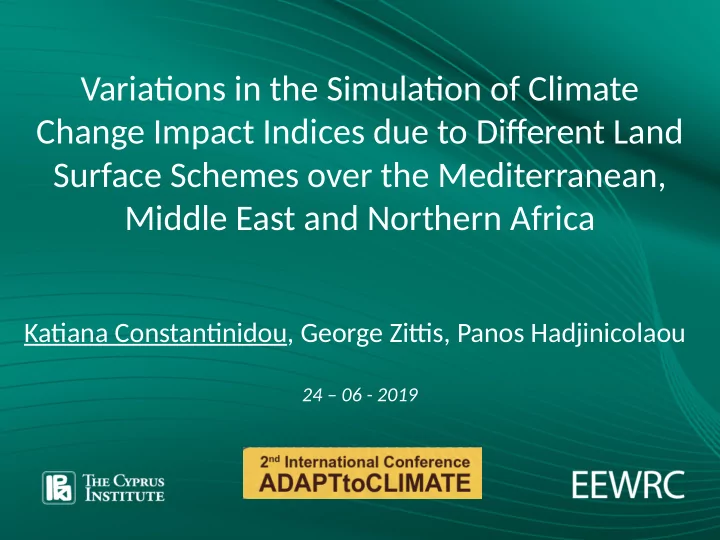

Variatjons in the Simulatjon of Climate Change Impact Indices due to Difgerent Land Surface Schemes over the Mediterranean, Middle East and Northern Africa Katjana Constantjnidou, George Zittjs, Panos Hadjinicolaou 24 – 06 - 2019
Introductjon Recent past: Mediterranean, Middle East and Northern Africa High temperatures & dryness Future: More extreme climatic conditions Ecosystem & societal impacts
Introductjon Regional Climate models (RCM) used for climate simulations (downscaling technique) RCMs have uncertainties that The output of the simulations are related to the representation are affected by different of the dynamical & physical sources of uncertainty processes Land-Atmosphere interactions play an important role in climate through the exchange of heat, moisture & radiation between the ground and the air above it. Land Surface Schemes (LSSs) are used to represent land surface processes in climate models
Introductjon Consequences on society Changes in prevailing climatic and natural ecosystems, conditions simulated by RCMs projected and evaluated by impact assessments Objective : to explore the implied uncertainty of the variations of certain climate change impact related indices as it is induced by the modelled climate from different land surface schemes. Radiative Index of Fuel Dryness Water-limited Dryness (RID) Index (Fd) Yield (Yw)
Methodology Data: RCM: Weather Research Forecast ( WRF ) version 3.8.1 Boundary conditions: ERA-Interim reanalyses Horizontal resolution : 50 km Time period : December 2000 – November 2010 Domain : MENA-CORDEX (Coordinated Regional Climate Downscaling Experiment) Experiment No. Land Surface Scheme Number of soil layers run1 Noah 4 run2 NoahMP 4 (dynamic vegetation = OFF) run3 NoahMP 4 (dynamic vegetation = ON) run4 CLM 10 run5 RUC 6 run6 RUC 9
Methodology Impact Indices: Radiative Index of Dryness (RID) A non-dimensional measure of the long-term balance between rainfall and net radiation r n → net radiation λH → latent heat flux p → precipitation Budyko et. al. 1974
Methodology Impact Indices: Fuel Dryness Index (Fd) A simple way to calculate fuel moisture content and assess the fire risk in an area r n → net radiation LH→ latent heat flux G → ground heat flux Snyder et. al. 2006
Methodology Impact Indices: Water-limited yield (Yw) Agro-Ecological Zones (AEZ) methodology to assess the suitability of crops and to quantify expected production. Crop: Durum wheat 1. thermal suitability test: result to the suitable (Triticum tirgidum) gird-boxes for cultivation of a certain crop Growing cycle: 180 days 1 st November - 30 th April 2. potential crop yields are calculated with regard to the prevailing temperature and radiation regimes 3. water-limited yield are derived using the potential yields and a water-stress limiting factor Constantinidou et. al. 2016
Results Sub-domains: Western Mediterranean Central Mediterranean Eastern Mediterranean Balkans Anatolia Mesopotamia For each of the sub-domain and for every index mean values derived from the 6 experiments, the difference (Δ) of each run from the overall mean value , two times the standard deviation and “relative dispersion” ( 2σ/mean(r1:r6) ) are calculated.
Results
Results 2*σ – 2 * standard deviation Rel. Disp. - “Relative dispersion”
Results
Results 2*σ – 2 * standard deviation Rel. Disp. - “Relative dispersion”
Results
Results 2*σ – 2 * standard deviation Rel. Disp. - “Relative dispersion”
Summary & Conclusions Aim : to investigate the variations in the estimation of three climate change-related indices from RCM output due to different LSS. The indices are: Radiative Index of Dryness (RID), the Fuel Dryness Index (Fd) & Water-limited Yield (Yw) of durum wheat. 6 performed simulations using the WRF RCM WRF RCM over the MENA-CORDEX MENA-CORDEX domain driven by ERA-Interim ERA-Interim reanalysis data for the period of 2000–2010 2000–2010 using 4 different LSSs 4 different LSSs (Noah, NoahMP, CLM and RUC). The indices directly related to certain impact sectors are found to be sensitive to the choice of LSSs employed.
Summary & Conclusions RID: CLM simulations deviate the most from Noah (reference) and gives less dry simulated conditions (Δ CLM) MENA’s relative dispersion = 1 (0 < RID < 4) Fd (JJA): Most vulnerable areas: western Mediterranean and Balkans Fire potential: CLM and both options of NoahMP - high RUC → reduced Fd (JJA) ==> Noah: highest & RUC: lowest “Relative dispersion”: sub-domains = 0.2 - 0.4, MENA region ~ 25% Yw (Durum wheat): Southern & most of the northern parts of MENA: not suitable All LSSs (except CLM): lower values compared to Noah Yw ==> Mesopotamia:lowest & western Mediterranean highest “Relative dispersion”: MENA ~ 10%, sub-regions up to 40% A certain degree of uncertainty in these indices should be expected because of the land surface treatment.
Thank you !!! Katjana Constantjnidou k.constantjnidou@cyi.ac.cy
Recommend
More recommend